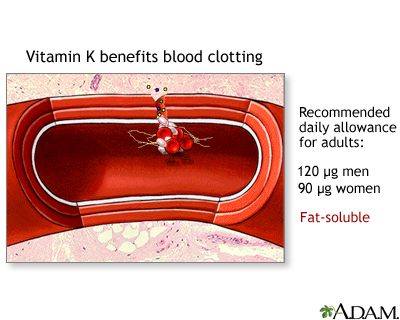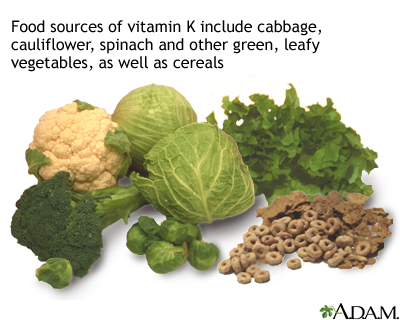Vitamin K
Phylloquinone; K1; Menaquinone; K2; Menadione; K3
Vitamin K is a fat-soluble vitamin. Your body stores vitamin K in the liver and other body tissues, including the brain, heart, pancreas, and bone.
Images


Function
Vitamin K is known as the clotting vitamin. The body needs vitamin K to make certain proteins in the liver that cause blood to clot. These proteins are called clotting factors. Without vitamin K, the liver could not produce clotting factors II, VII, IX, and X, and blood would not clot. Some studies suggest that vitamin K helps maintain strong bones in older adults.
Food Sources
The best way to get the daily requirement of vitamin K is by eating food sources. Vitamin K is found in the following foods:
- Green leafy vegetables, such as kale, spinach, turnip greens, collards, Swiss chard, mustard greens, parsley, romaine, and green leaf lettuce
- Vegetables such as Brussels sprouts, broccoli, cauliflower, and cabbage
- Fish, liver, meat, eggs, and cereals (contain smaller amounts)
Vitamin K is also made by the bacteria in the lower intestinal tract.
Side Effects
Vitamin K deficiency is very rare. It occurs when the body can't properly absorb the vitamin from the intestinal tract. Vitamin K deficiency can also occur after long-term treatment with antibiotics.
People with vitamin K deficiency are often more likely to have bruising and bleeding.
Keep in mind that:
- If you take the blood-thinning drug warfarin (Coumadin), you may need to eat less of vitamin K containing foods.
- Even more important, you may also need to eat the same amount of vitamin K-containing foods every day. Sudden changes in vitamin K consumption can change the effect of this medicine.
- You should know that vitamin K or foods containing vitamin K can affect how warfarin works. It is important for you to keep vitamin K levels in your blood constant on a day to day basis.
Ask your health care provider if you need to monitor your intake of vitamin K containing foods and how much you can eat.
Recommendations
Recommendations for vitamin K, as well as other nutrients, are provided in the Dietary Reference Intakes (DRIs) developed by the Food and Nutrition Board at the National Academies of Sciences, Engineering, and Medicine. DRI is a term for a set of reference intakes that are used to plan and assess the nutrient intakes of healthy people. These values, which vary by age and sex, include:
Recommended Dietary Allowance (RDA): The average daily level of intake that is enough to meet the nutrient needs of nearly all (97% to 98%) healthy people. An RDA is an intake level based on scientific research evidence.
Adequate Intake (AI): This level is established when there is not enough scientific research evidence to develop an RDA. It is set at a level that is thought to ensure enough nutrition.
Dietary reference intakes for vitamin K:
Infants (AI)
- 0 to 6 months: 2.0 micrograms per day (mcg/day)
- 7 to 12 months: 2.5 mcg/day
Children (AI)
- 1 to 3 years: 30 mcg/day
- 4 to 8 years: 55 mcg/day
- 9 to 13 years: 60 mcg/day
Adolescents and adults (AI)
- Males and females age 14 to 18: 75 mcg/day (including those females who are pregnant and lactating)
- Males age 19 and older: 120 mcg/day
- Females age 19 and older: 90 mcg/day (including those who are pregnant and lactating)
References
Markell M, Siddiqi HA. Vitamins and trace elements. In: McPherson RA, Pincus MR, eds. Henry's Clinical Diagnosis and Management by Laboratory Methods. 24th ed. Philadelphia, PA: Elsevier; 2022:chap 27.
Mason JB, Booth SL. Vitamins, trace minerals, and other micronutrients. In: Goldman L, Schafer AI, eds. Goldman-Cecil Medicine. 26th ed. Philadelphia, PA: Elsevier; 2020:chap 205.
National Institutes of Health website. Vitamin K: fact sheet for health professionals. ods.od.nih.gov/factsheets/VitaminK-HealthProfessional/. Updated March 29, 2021. Accessed February 21, 2023.
BACK TO TOPReview Date: 1/19/2023
Reviewed By: Stefania Manetti, RD/N, CDCES, RYT200, My Vita Sana LLC - Nourish and heal through food, San Jose, CA. Review provided by VeriMed Healthcare Network. Also reviewed by David C. Dugdale, MD, Medical Director, Brenda Conaway, Editorial Director, and the A.D.A.M. Editorial team. Editorial update 04/26/2023.

Health Content Provider
06/01/2025
|
A.D.A.M., Inc. is accredited by URAC, for Health Content Provider (www.urac.org). URAC's accreditation program is an independent audit to verify that A.D.A.M. follows rigorous standards of quality and accountability. A.D.A.M. is among the first to achieve this important distinction for online health information and services. Learn more about A.D.A.M.'s editorial policy, editorial process and privacy policy. A.D.A.M. is also a founding member of Hi-Ethics. This site complied with the HONcode standard for trustworthy health information from 1995 to 2022, after which HON (Health On the Net, a not-for-profit organization that promoted transparent and reliable health information online) was discontinued. |
The information provided herein should not be used during any medical emergency or for the diagnosis or treatment of any medical condition. A licensed medical professional should be consulted for diagnosis and treatment of any and all medical conditions. Links to other sites are provided for information only -- they do not constitute endorsements of those other sites. © 1997- 2025 A.D.A.M., a business unit of Ebix, Inc. Any duplication or distribution of the information contained herein is strictly prohibited.
